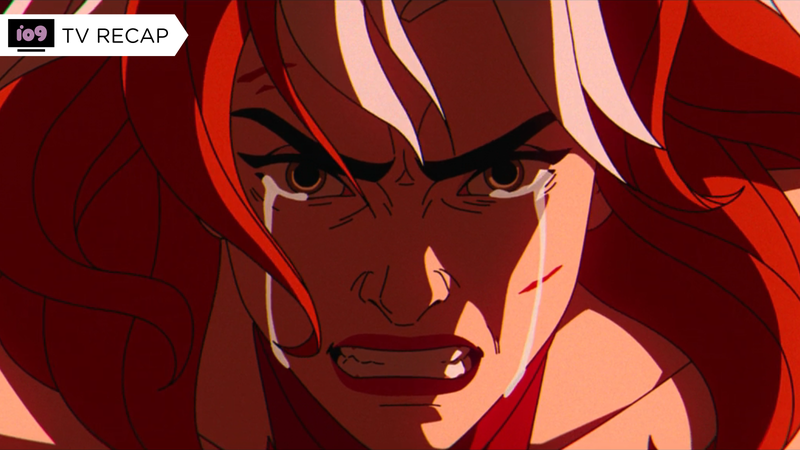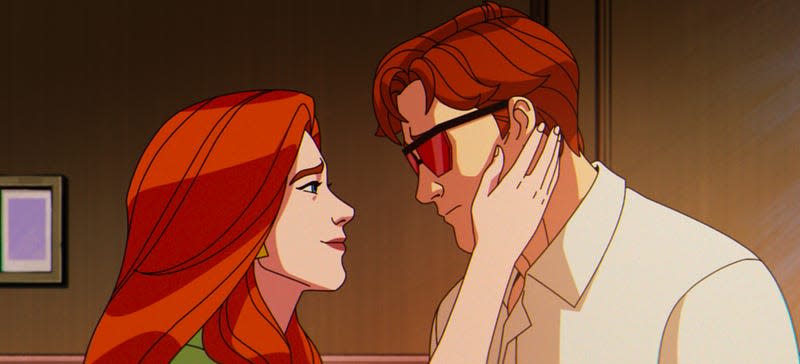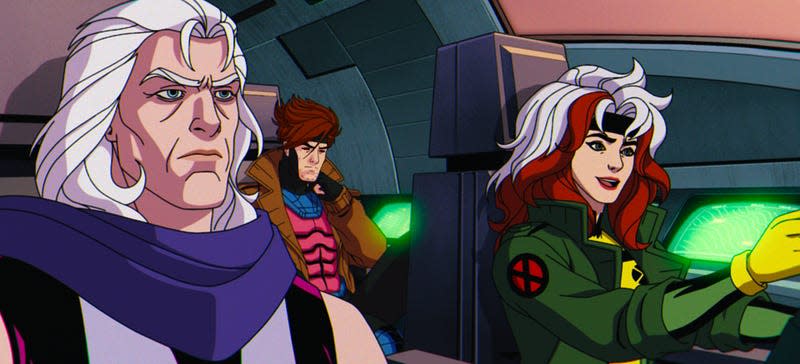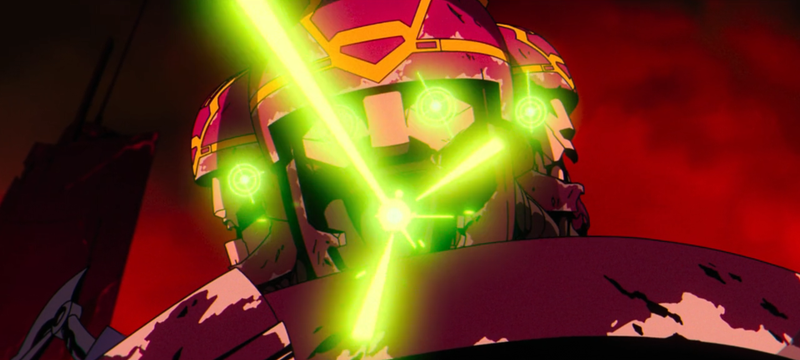X-Men '97 Just Gave Us Charles Xavier's Dream—And His Nightmare

The story of Marvel’s mutantdom is one of evolution, and with it, cycles—the rise and fall that almost always guarantees that the tale of the X-Men is one of endless battle, for a world that hates and fears them. Throughout their comic book history, two stories of their rise, and their bitter fall, become entwined on X-Men ‘97, in an episode galvanizes the series with an evolution of its own.

It is impossible to extricate “Remember It,” the fifth episode of Disney+ series X-Men ‘97, from the layers of comic book context it is wrapped in, let alone its story of genocide arriving at, whether it wants to or not, a point of very real parallels to our own world. After an opening half that has played with the nostalgia of returning to this very specific take on the X-Men—both the perils that entails, as well as the allure of it—“Remember It” throws a bucket of cold water over the warmth of that familiarity to take on one of the biggest moments in X-Men comics history: the Genoshan Genocide.
But in some ways, it’s also the story of Krakoa—mutantkind’s second, more recent attempt in the comics at a nation state. First introduced as a new status quo in 2019 by the writer Jonathan Hickman, readers have only really just recently seen Krakoa laid low, in similar style to how Genosha itself fell in the comics nearly 24 years ago—mostly off panel, in the first arc of Grant Morrison and Frank Quitely’s New X-Men. But that means, in and of itself, that X-Men: The Animated Series was reborn as X-Men ‘97 in the crucible of this second mutant state, and the parallels between what it uses to show us life on Genosha largely left unseen in the comics with the ascendancy of the Krakoan Age are clear.
Even without key underpinnings of Krakoa like the idea of Mutant resurrection at play, and the specific power balance that created, the stories of Genosha, of Krakoa, and now X-Men ‘97's fusion of the two, are all important contexts. It’s perhaps fitting then, that in some ways the broad story of “Remember It” and its horrifying reckoning with Genosha’s fate mirrors the three laws that forged Krakoan society.

Make More Mutants
The opening half of “Remember It” delves into the formal admission of Genosha—established as a sovereign nation in the later seasons of X-Men: The Animated Series—from two halves. While Magneto, Gambit, and Rogue head to the nation to prepare for its induction into global political society, in Westchester the remaining X-Men put on their own diplomatic faces as they prepare to face the press (represented here by journalistic comics stalwart and one time paramour of Beast, Trish Tilby) to discuss the moment in history.
They are, however, the X-Men, which means things two things: first, they have been through a lot recently, as usual. Second, they are a mess of soap operatic relationships and drama. This combines to blow up in their faces at the worst time—except now, it’s caught on camera.
Most of this, of course, focuses on the return of Jean Grey after ‘97's rushed riff on “Inferno” a few episodes ago. As she tries to navigate her own thoughts and memories of life separate from the woman who became Madelyne Pryor, Jean finds her emotions over Scott, Logan, and even the child Nathan Summers too overwhelming—simmering to the surface and flourishing into an ill-advised kiss with Logan, and then in turn anger, as she discovers that Scott has been psionically communicating with Madelyne after she left the mansion behind. Scott, in turn, is also angry: when Trish confronts him mid-interview about Nathan and his seeming absence, Scott’s initial facade as the Boy Scout team leader representing his people falls, and his bitterness—the sacrifice he made, the work he does to protect a world that wants him dead, the inability to explain the insanity of his life to a human being contrasted with the whole point of this interview as a way to show humanity mutantkind’s similarity to its sibling species—explodes, exploding further still when Jean confronts him about Madelyne... with Trish’s camera still rolling.
It’s all a bit Mutant Divorce Court, but it all comes back to what Genosha represents: the chance for mutant life to thrive, in all its beautiful, complicated, messy forms, in a place where it can be given the space and protection to do so. The very real emotions Jean and Scott have over Nathan—over the future he represented—are wreathed in layers of wild comic book superhero context, but they are, as dramatically explosive as they are at mucking up the X-Men’s press blitz, incredibly human. For all Scott rails at Trish that his people are nothing like humans, in the end, mutant and human alike all want similar things: homes, livelihoods, connects, a chance to make futures with each other.

Murder No Man
This mutant drama—and dreams of a future togetherness—is tied into the Genoshan side of “Remember It” in Rogue, Magneto, and Gambit’s own simmering romantic tension. What was in the background earlier in X-Men ‘97 comes to the fore here as the love triangle finds itself entangled in the distasteful business of running a nation. Magneto has been summoned to Genosha not just to represent the X-Men during its admission alongside Valerie Cooper, but to join its council (itself a fascinating parallel to Krakoa’s Quiet Council, including the addition of villainous entities like Sebastian Shaw and Emma Frost of the Hellfire Club, Madelyne herself as its latest member, and right down the presence of one Moira MacTaggert) as Chancellor: the inheritor of Charles Xavier’s dream, in all its parts.
While Gambit and Rogue tour Genosha with the help of Nightcrawler, and see its thriving Mutant life—and see some of the cost of that life in an uneasy world where the nation lacks the cards in play Krakoa eventually would (no Hellfire Trading Company here means $10 apples, apparently)—Magneto tackles the curveball he’s given with a wild counteroffer. He will lead Genosha under one condition: he will not be its king, but he will have a queen in the form of an X-Men representative to be at his side... Rogue, in the hopes that he can re-spark the lingering romantic history between them.
This is mutant soap opera once again—as Rogue tearfully spills to Gambit about her past with Magneto, and how she yearns to love him in the way she loves her, but can’t due to the touch of her absorption powers—but it’s also another fascinating parallel X-Men ‘97 draws to Genosha as a nation state with Krakoa. Magneto’s play here is as much political as it is personal. Yes, he still has feelings for Rogue, but this is also a manipulation of the soft power Genosha has in statecraft. Magneto is still seen, in spite of his trial in the premiere, as a terrorist. But in leading alongside a prominent member of the X-Men—loving them, performing the same play for emotion as the X-Men were playing being interviewed by Trish Tilby—he draws the parallels between mutant kind and humanity that paves the path for assimilation, that these people they hate are so alike them, loving like them, caring like them, and willing to change.
So when Rogue accepts, breaking Gambit’s heart in the process, Genosha’s soft power scores its first political victory—and the parallels to Krakoa emerge once more, as the two make their public debut in a glitzy, disco-fueled dance, enhanced by the powers of Dazzler and fireworks that draw a visual link to the first night Krakoa celebrated its own establishment as a nation state in House of X #6: a gala to show just how mutant society can bring powers and peoples of all kinds together into something new and exciting, if given the chance to flourish.
But what we get is a gala of a very different kind of Hellfire.

Respect This Sacred Land
Because you see, for all the parallels X-Men ‘97 makes between its version of Genosha and Krakoa, the former lacks what the latter always had: the ability to back up its soft power with hard power. Genosha’s history in the comics, from a apartheid state to the cut-short potential for a mutant civilization, is defined by the precarity of its existence. It’s almost why its genocide occurs off panel in New X-Men—like an acknowledgement that its violent end was just an inevitability. Krakoa, meanwhile, is forged in a manner that allowed it to exist for as long as it did as a status quo in the comics (these days, five years might as well be 15), because its foundation was built on huge swaths of power to make mutantkind ascendant: not just the powers of its peoples, but the land itself. Krakoa gave mutants economic power in access to life-changing medicines it could trade, its organic, mutant-only gateways an access that, for the most part, occurred on mutant terms, not human ones.
But above all, Krakoa gave mutantkind the answer to solve death itself, the resurrection protocols that rewrote years of mutant history in the face of trauma, and gave a species almost defined by death and persecution a chance to stare it in the eye and say “No.” Genosha never had that, and for all X-Men ‘97's version borrows from Krakoa, it does not take this way to cheat death. So when Rogue and Magneto’s dance is interrupted by the emerald beams of the Sentinel Master Mold (in another fitting parallel, the reveal that Charles and Magneto had discovered a way to resurrect the dead in the Krakoan Age was through a suicide mission to disable a new Master Mold, too) making landfall, there is no way to say “No.” There is only death and destruction.
If the Krakoan age examined mutantkind’s perpetual dance with death and loss—and its similarly metatextual dance with always coming back, in spite of that—as a defiant affront to the Genoshan Genocide, X-Men ‘97 has no particular interest in taking that examination on itself just yet. What we see here is death, real and seemingly permanent, as ream after ream of Genoshan citizens burn to ash before our eyes.
There is a sense of shock value here in the carnage, unlike anything X-Men ‘97 has played with thus far, a way to set it apart from the shackles of making a children’s animated series in the 1990s. But that does not mean that X-Men ‘97 is disinterested in examining the cost of such utter carnage: while the comics largely isolated Genosha’s genocide to characters unseen or rarely known, examining the trauma in the aftermath, here death is given weight and meaning to fundamentally alter the path X-Men ‘97 lured us into thinking it was going down in its playful nostalgia. As Sentinel after Sentinel lances fire and blood across our screens, these are not just faceless people—but characters we know, from the comics, from X-Men: The Animated Series’ own legacy... and our very heroes, when it comes for both Magneto and Gambit to pay the ultimate price to defeat the Master Mold, leaving a devastated, bawling Rogue to mourn over their broken bodies.
It’s a fascinating choice to make Rogue the face of the Genoshan Genocide in X-Men ‘97. In some ways in the comics, it was Emma Frost, the turning point to more deliberately position her as part of the X-Men instead of an antagonist, bearing the weight of watching her students butchered as she did in New X-Men. But in giving Genosha’s fall such a devastating personal cost to the series in killing off both Magneto and Gambit in the mayhem, Rogue, linked to them both in her love for them, gives us a fascinating character to further explore the impact of this horror in the ways X-Men stories always do best: a messy, complicated, but deeply personal and human lens.
There are, perhaps, ways to come back from this. As I said, mutants have long had an uncanny knack for not actually dying when we’re told they have, long before the resurrection protocols. Killing off characters as iconic to X-Men’s animated legacy as Magneto and Gambit in one fell swoop just primes an audience familiar with superhero storytelling to imagine, to hope for, a way out from this immediate shock. But that doesn’t take away from what X-Men ‘97 masterfully achieves in “Remember It.”
X-Men stories have long followed in the grand tradition of extinction and survival. It is only fitting that X-Men ‘97 follows suit—and in doing so, it proves that the series not only has the chops to smartly play with X-Men: The Animated Series’ nostalgic legacy, but has the teeth to dig into the most vital and dark underpinnings of the X-Men’s comics history, too.
X-Men ‘97 is available to stream now on Disney+.
Want more io9 news? Check out when to expect the latest Marvel, Star Wars, and Star Trek releases, what’s next for the DC Universe on film and TV, and everything you need to know about the future of Doctor Who.

